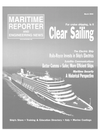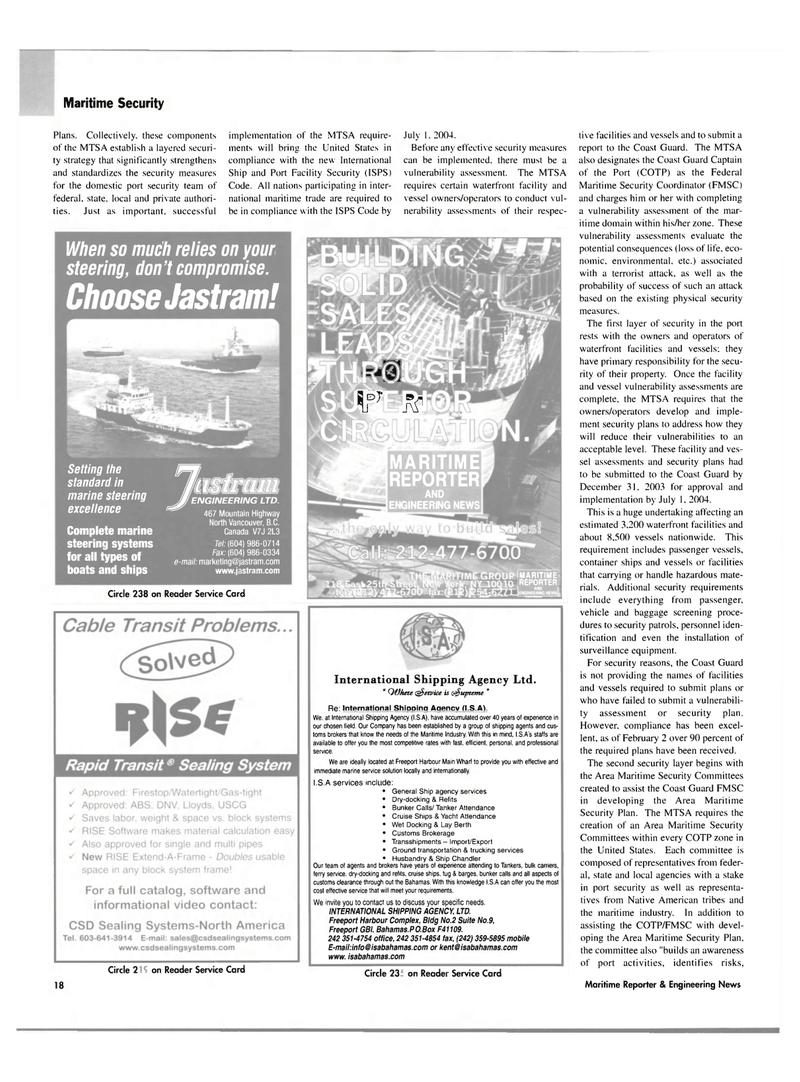
Page 18: of Maritime Reporter Magazine (March 2004)
The Cruise Shipping Edition
Read this page in Pdf, Flash or Html5 edition of March 2004 Maritime Reporter Magazine
Maritime Security
Plans. Collectively, these components of the MTSA establish a layered securi- ty strategy that significantly strengthens and standardizes the security measures for the domestic port security team of federal, state, local and private authori- ties. Just as important, successful implementation of the MTSA require- ments will bring the United States in compliance with the new International
Ship and Port Facility Security (ISPS)
Code. All nations participating in inter- national maritime trade are required to be in compliance with the ISPS Code by
July 1. 2004.
Before any effective security measures can be implemented, there must be a vulnerability assessment. The MTSA requires certain waterfront facility and vessel owners/operators to conduct vul- nerability assessments of their respec- tive facilities and vessels and to submit a report to the Coast Guard. The MTSA also designates the Coast Guard Captain of the Port (COTP) as the Federal
Maritime Security Coordinator (FMSC) and charges him or her with completing a vulnerability assessment of the mar- itime domain within his/her zone. These vulnerability assessments evaluate the potential consequences (loss of life, eco- nomic. environmental, etc.) associated with a terrorist attack, as well as the probability of success of such an attack based on the existing physical security measures.
The first layer of security in the port rests with the owners and operators of waterfront facilities and vessels: they have primary responsibility for the secu- rity of their property. Once the facility and vessel vulnerability assessments are complete, the MTSA requires that the owners/operators develop and imple- ment security plans to address how they will reduce their vulnerabilities to an acceptable level. These facility and ves- sel assessments and security plans had to be submitted to the Coast Guard by
December 31. 2003 for approval and implementation by July 1, 2004.
This is a huge undertaking affecting an estimated 3,200 waterfront facilities and about 8,500 vessels nationwide. This requirement includes passenger vessels, container ships and vessels or facilities that carrying or handle hazardous mate- rials. Additional security requirements include everything from passenger, vehicle and baggage screening proce- dures to security patrols, personnel iden- tification and even the installation of surveillance equipment.
For security reasons, the Coast Guard is not providing the names of facilities and vessels required to submit plans or who have failed to submit a vulnerabili- ty assessment or security plan.
However, compliance has been excel- lent, as of February 2 over 90 percent of the required plans have been received.
The second security layer begins with the Area Maritime Security Committees created to assist the Coast Guard FMSC in developing the Area Maritime
Security Plan. The MTSA requires the creation of an Area Maritime Security
Committees within every COTP zone in the United States. Each committee is composed of representatives from feder- al, state and local agencies with a stake in port security as well as representa- tives from Native American tribes and the maritime industry. In addition to assisting the COTP/FMSC with devel- oping the Area Maritime Security Plan, the committee also "builds an awareness of port activities, identifies risks,
When so much relies on your steering, don't compromise.
Choose Jastram!
Setting the standard in marine steering excellence
Complete marine steering systems for all types of boats and ships
J ^ENGINEERING LTD. 467 Mountain Highway
North Vancouver, B.C.
Canada V7J 2L3
Tel: (604) 986-0714
Fax: (604) 986-0334 e-mail: [email protected] www.jastram.com
Circle 238 on Reader Service Card
Circle 285 on Reader Service Card 18
MARITIME REPORTER > A s | D)t u St
J \A ,
MARITIME REPORTER
AND
ENGINEERING NEWS
Circle 273 on Reader Service Card
Maritime Reporter & Engineering News
International Shipping Agency Ltd. " Q4)kete Service is <~§itpreme "
Re: International Shipping Agency (I.S.A).
We. at International Shipping Agency (I S A), have accumulated over 40 years of experience in our chosen field. Our Company has been established by a group of shipping agents and cus- toms brokers that know the needs of the Maritime Industry. With this in mind, I S A's staffs are available to offer you the most competitive rates with fast, efficient, personal, and professional service.
We are ideally located at Freeport Harbour Main Wharf to provide you with effective and immediate marine service solution locally and internationally.
I.S.A services include: • General Ship agency services • Dry-docking & Refits • Bunker Calis/Tanker Attendance • Cruise Ships & Yacht Attendance • Wet Docking & Lay Berth • Customs Brokerage • Transshipments - Import/Export • Ground transportation & trucking services • Husbandry & Ship Chandler
Our team of agents and brokers have years of experience attending to Tankers, bulk carriers, ferry service, dry-docking and refits, cruise ships, tug & barges, bunker calls and all aspects of customs clearance through out the Bahamas. With this knowledge I.S.A can offer you the most cost effective service that will meet your requirements.
We invite you to contact us to discuss your specific needs.
INTERNATIONAL SHIPPING AGENCY, LTD.
Freeport Harbour Complex, Bldg No.2 Suite No.9,
Freeport GBI, Bahamas.P.O.Box F41109. 242 351-4754 office, 242 351-4854 fax, (242) 359-5895 mobile
E-mail:[email protected] or [email protected] www.isabahamas.com

 17
17

 19
19
